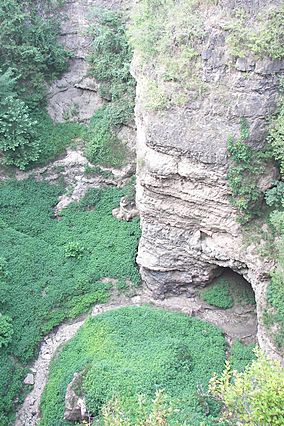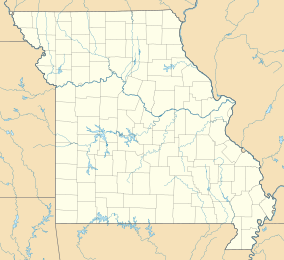Grand Gulf State Park (Missouri) facts for kids
Quick facts for kids Grand Gulf State Park |
|
|---|---|

Water entering this cave reappears nine miles (14 km) away at Mammoth Spring.
|
|
| Location | Oregon, Missouri, United States |
| Area | 321.96 acres (130.29 ha) |
| Elevation | 712 ft (217 m) |
| Established | 1984 |
| Governing body | Missouri Department of Natural Resources |
| Website | Grand Gulf State Park |
| Designated: | June 1971 |
Grand Gulf State Park is a really cool natural area in Missouri. It's near a town called Thayer. This park is special because it has a huge canyon. This canyon was once a giant cave system. Over a very long time, the cave's roof collapsed.
The park covers about 322 acres (130 hectares). It's managed by the Missouri Department of Natural Resources. This has been happening since 1984. A famous conservationist named Leo Drey helped protect this land.
Grand Gulf was named a National Natural Landmark in 1971. This means it's a very important natural place. It shows a great example of something called karst topography. This is a type of landscape where water dissolves rock. It also shows how underground rivers can "steal" water from other streams.
A smaller part of the park, about 60 acres (24 hectares), is even more protected. It was named the Grand Gulf Natural Area in 1986. This helps keep its unique features safe.
What Makes Grand Gulf Special?
The Grand Gulf is a long, deep canyon. It stretches for almost 1 mile (1.6 km). In some places, its sides are very steep. They can be as deep as 130 feet (40 meters). Imagine looking down into such a huge crack in the Earth!
The Natural Bridge
One of the most amazing things here is a giant natural bridge. It's part of the original cave roof that didn't collapse. This bridge is about 250 feet (76 meters) long. It's one of the biggest natural bridges in all of Missouri. It's like a huge stone archway.
Water's Journey
A large area of land, about 28 square miles (73 square km), drains water into the gulf. All this water flows into a cave entrance at the eastern end of the canyon. But where does it go after that?
Scientists have used a method called dye tracing to find out. They put a special dye into the water at Grand Gulf. Then, they watched to see where the colored water would appear. It turns out the water travels a long way! It comes out at Mammoth Spring in Arkansas. This spring is about 9 miles (14 km) away. The water takes 1 to 4 days to make this underground journey.
Things to Do at the Park
Grand Gulf State Park is a great place to visit. It has areas where you can enjoy a picnic. There are also two trails for walking. These trails let you get great views of the amazing gulf.
The park has many trees and plants. Because of this, the best times to visit are in the fall and winter. During these seasons, the leaves have fallen. This makes it easier to see the deep canyon and its unique features.



